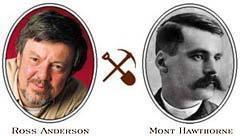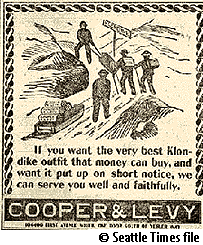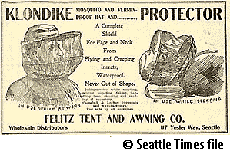
|
 
Copyright © 1997 The Seattle Times Company
Monday, June 30, 1997
Trip to goldfields begins
with trip to store
by Ross Anderson
Seattle Times staff reporter

"I gotta have a year's supply of grub," Mont Hawthorne instructed his grocer back in 1897.
"It's got to be first-rate stuff. The list can be changed at your suggestion, but I've given
it considerable thought."
So began Mont's Klondike expedition in 1897-99. Hardly a romantic beginning.
"I'd rather pack 150 pounds all day than go shoppin'," he recalled later.
Me, too.
But it's 1,500 miles from Seattle to Dawson City and the gold fields -- 900 miles
up the Inside Passage to Skagway, 35 miles of heavy packing over the Chilkoot Pass,
then 550 miles through subarctic lakes and down the Yukon River.
Seeing as how Mont, my historical traveling companion and guide, has been there before,
I paid particular attention to his "Yukon outfit."
He started with his grub. A year's supply of flour, sugar, baking powder,
soda, chocolate, bacon shortening, syrup, rice, beans, canned milk, dried pears,
peaches, apples, raisins and prunes.

"Don't cotton much to prunes," Mont explained. "But they're good to have."
His food was packed in heavy canvas bags with no labels. Just a number. That way,
any thief along the trail wouldn't know if he was stealing a bag of chocolate, beans or sand.
A stout Mackinaw coat, two heavy shirts, red flannel underwear, two pairs of
woolen mittens, two wool caps, lots of wool socks -- all knitted by his aging mother.
Two pairs of heavy wool pants, three pairs of cotton pants, cotton overalls big enough
to fit over his woolen pants.
"You can freeze to death easy in wool, cause the wind goes right through it," Mont explained.
"But if you got cotton on the outside of the wool, you keep all the heat of your body."
Gotta sleep warm up North. So Mont bought two wool blankets. One weighed 14 pounds.
He sewed them together into a sleeping bag, designed so he could put a canvas cover on the outside.
Hammer and nails. A hand drill with an inch-and-a-quarter bit. Ax and square.
Handsaw and ripsaw for making a boat plumb. Caulking chisel, oakum for sealing boat seams,
oar locks and fishing hooks, including big "shark hooks."
"They always come in handy for getting bodies out after drownings."
Rope, pick and shovel. Goldpan. Quicksilver for gathering fine gold. Pitch, and a pot to
melt it in. Canvas tent. Ammunition for a .30-.40 Winchester rifle and for a .44 revolver.
Folding Yukon stove, pans, skillet, two strong buckets, box of candles, matches packed in a tin.
Two hickory Yukon sleds, made light and strong, 6 feet long by 16 inches wide.
A medicine kit with old linen napkins boiled for bandages, epsom salts,
tincture of benzoine, turpentine, mosquito netting, homemade soap and sewing supplies.

Then there were the two dogs. Pedro, a big, red-haired part-St. Bernard, and a black Newfoundland.
Mont also gave serious thought to taking a couple of cats. "Cats is useful," he explains.
"And they are good company besides. I figgered I could kill birds along the trail to feed them.
And then I could make a lot of money selling kittens to lonesome prospectors in Dawson.
"I was fool enough to let folks laugh me out of those cats. I could've sold them in Dawson
for fifty dollars apiece, easy."
As an afterthought, Mont packed his outfit in a big, wooden piano
crate to protect it from rats on the steamer trip. When everything was packed,
the crate weighed 2,600 pounds. Mont figured he was ready to go.
Fortunately, my outfit is less complicated. And 2,540 pounds lighter.
But it still took a couple of weeks to assemble, then whittle down.
Two pounds of oatmeal, a half-pound of French Roast coffee, a dozen paper coffee filters,
a dozen granola bars, powdered milk, instant cocoa, tea bags, one can of chicken, one can of
clams, three "gourmet" trail meals (of which I am highly skeptical), five packets of
various pasta dishes, two pounds of trail mix with dried fruit and nuts, spices, olive oil...
And dried prunes, an appreciation I share with Mont and few others.
My grub is stowed in Ziploc baggies, guaranteed to cause no confusion among thieves.
Then there is the hardware. Large pocketknife, pocket tool, MSR stove with two bottles of fuel, two-man tent (6 pounds), 2 1/2-pound sleeping bag, self-inflating pad,
ground tarp, overhead tarp converted from old rainfly, binoculars, small porcelain-coated pot,
water bottle, all-purpose bowl, eating utensils, insulated coffee cup, three Bic lighters,
50 feet of nylon line, first-aid kit with lots of Ibuprofin, one can of mosquito repellent,
one can of pepper spray for fending off bears.
Heavy fleece shirt and pants, trail pants made of unknown miracle fabric,
two pairs of nylon shorts with lots of pockets, cotton T-shirt, polypropylene long johns,
five pairs of socks and a lightweight nylon rainjacket.
Five reporters notebooks, a half-dozen pens, waterproof notebook, weatherproof
35mm camera, five rolls of film, paperback editions of Pierre Berton, Tappan Adney,
Murray Morgan and Jack London. . . . And a dog-eared copy of "The Trail Led North --
Mont Hawthorne's Story," thoroughly underlined and annotated, and carefully stowed
in its own waterproof bag. ("Well, I'll be danged!," Mont declares, which is the
closest he gets to a profanity.)
My outfit rides in a brand-new, internal-frame backpack. It fits, barely,
but only after some shedding.
"What's all that weigh?," Mont wants to know.
Sixty pounds. Fifty, without the books and stationery.
"Dang! That sure ain't gonna get you far!"
"It's OK, Mont. It's been a while. These days, we can resupply in
Whitehorse, and there are supermarkets in Dawson."
Mont is obsessed with my tent and polypropylene fleece. He fingers
it, smells it, furrows his brow.
"What's this stuff made of?" he asks.
Various chemicals. Petroleum. I understand the fleece is made from old milk cartons.
"Son, I wasn't born yesterday, you know."
"It's great stuff, Mont." Nylon sheds water far better than canvas.
The poly material wicks moisture away from the skin and dries quickly.
"So what's the downside?"
"You gotta be careful around fires."
"Why's that?'
"Well, it melts."
"Melts?"
Yup.
Mont's eyes light up. Well, when we get to Lake Bennett and start building
our boat, we can use this stuff to caulk the seams.
|